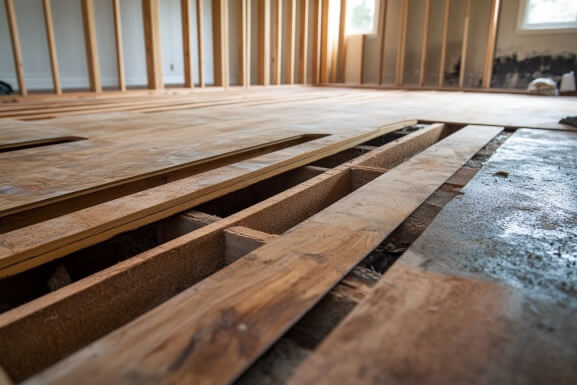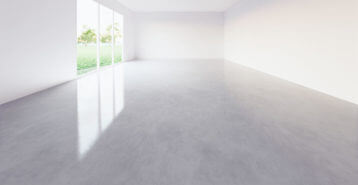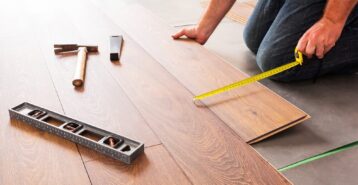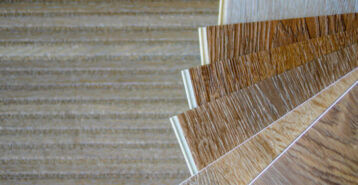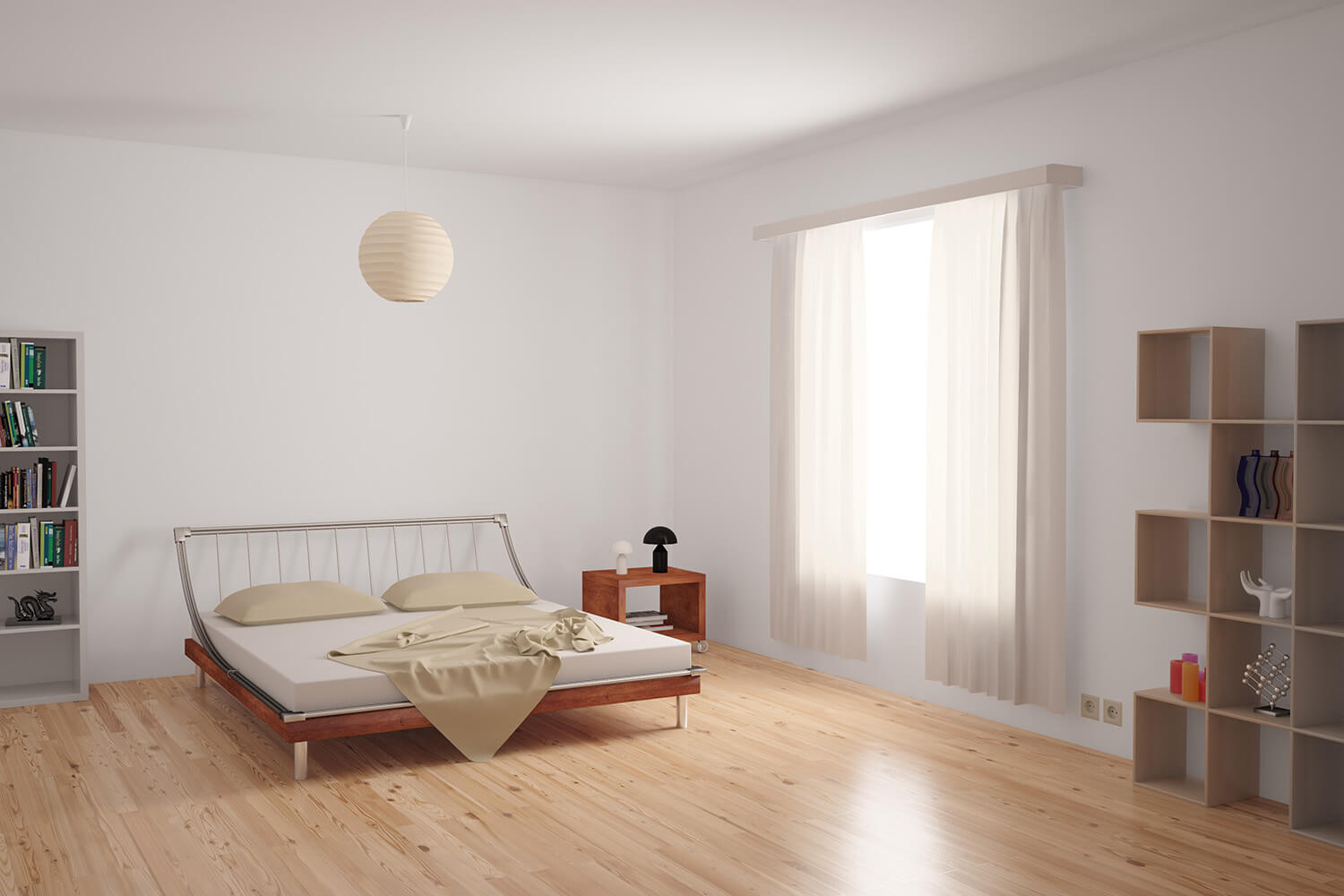What Is a Subfloor and Why Replace It?
Subfloors are the layers between your finished flooring and the supporting beams of your home. For instance, if you remove the luxury vinyl plank flooring in your bedroom, you may find padding or underlayment, followed by a rough layer made of plywood — this layer is the subfloor. Builders typically use plywood, wooden planks, or other materials to construct subfloors, which act as a barrier between your feet and the ground below.
Beneath the subfloor, you’ll find horizontal beams, known as joists, which are usually spaced about 16 inches apart. You can see these joists if you have a basement or crawl space.
You probably won’t notice the subfloor when it’s in good condition. However, as it ages, you may notice issues such as sagging or creaking floors, or you might experience a slight bounce when you walk. A weakened subfloor can severely damage the finished flooring above.

How Do You Know When to Replace Your Subfloor?
A well-installed subfloor can last up to 30 years. However, issues can arise earlier if it was not installed correctly, if lower-quality materials were used, or if there isn’t proper ventilation. Here are some signs your subfloor needs replacement:
- Sagging Floors: If parts of your floor are uneven or drooping, it may indicate problems with your subfloor.
- Creaking or Noises: New or persistent sounds (like popping) can mean the materials are weakened, even if some creaking is normal due to underlayment installation.
- Soft Spots: Areas that feel spongy or give way when you walk on them often need attention.
- Water Damage: Check for visible water damage, as it can lead to structural issues. After significant water damage, ensure the subfloor dries properly to prevent long-term problems.
- Gaps and Seams: Serious subfloor issues often cause noticeable gaps or seams in your flooring.
- Uneven Toilet: If your toilet feels unstable, it may be due to subfloor damage, especially in the bathroom, where water damage is common. Address this to prevent further issues.
- Odors: Mold or mildew smells often signal hidden water damage and subfloor problems.
Subfloor Replacement Cost Breakdown
Subfloor replacement is a major undertaking, with most projects ranging from $1,500 to $5,000. The total cost depends on the materials, labor, accessibility, and any additional repairs your contractor needs to complete.
Materials
- Plywood ($1.50 to $3 per square foot): Strong, durable, and the most common subfloor option.
- OSB ($1 to $2 per square foot): A budget-friendly option, though not as long-lasting as plywood.
- Moisture-Resistant or High-Performance Panels ($3 to $5 per square foot): Treated to withstand damp conditions; common brands include Amdry, DRIcore, and Barricade.
- Concrete: In certain homes, builders may use concrete instead of wood for durability and moisture resistance.
Labor
Labor is often the largest cost component. Most contractors charge $25 to $40 per hour, with projects taking 10 to 20 hours depending on size and complexity. Costs increase for kitchens, bathrooms, or areas with built-in cabinets that require removal. Skilled homeowners can attempt DIY subfloor replacement, but mistakes often cause costly repairs, so we recommend hiring a pro.
Other Factors Affecting Costs
- Area Size: The larger the area of the subfloor being replaced, the higher the project cost, due to increased material and labor requirements.
- Removal and Disposal: Contractors typically charge $200 to $500 to dispose of old subfloor material, depending on local fees.
- Joist Repairs: Repairing damaged joists usually adds $100 to $300 each to your total project cost, which can add up quickly.
- Mold Remediation: If water damage has caused mold, remediation costs will vary based on severity.
- Additional Repairs: Once demolition begins, contractors can identify any extra repairs your home may need. These could include plumbing modifications, the installation of underlayment or moisture barriers, or repairs for water damage.
- New Flooring: Replacing the subfloor involves removing the old flooring and installing a new one. The cost of new flooring typically ranges from $1 to $50 per square foot, not including labor.
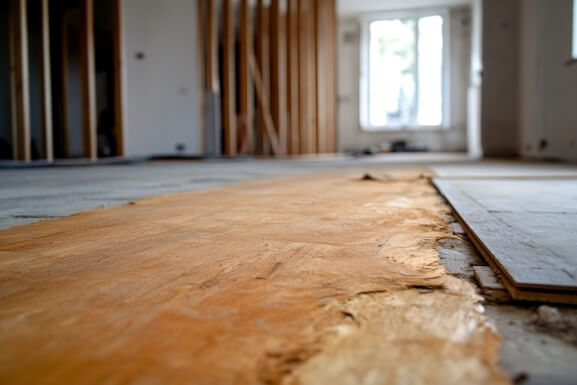
Why Should I Replace My Subfloor?
You should replace a broken or worn subfloor to maintain the stability and safety of your home. If you notice significant damage or deterioration in your subfloors, it’s important to begin planning and budgeting for a full replacement. Taking action now can help prevent further issues and extend the lifespan of your flooring.
Understanding the costs and factors that affect subfloor replacement enables you to address these concerns and maintain a safe, comfortable home environment.
Repair vs Full Replacement
It can be tempting to patch damaged sections instead of replacing the entire subfloor. Patching may cost less upfront, but it rarely fixes root causes, such as water damage or rotting joists. A full replacement is typically more cost-effective long term, providing up to 30 years of structural support.
When to Hire a Flooring Pro vs a Foundation Pro
Not all contractors handle the same subfloor issues. Flooring professionals fix surface-level problems, while foundation specialists handle structural concerns. Knowing which expert to call can save you both time and money.
Hire a flooring contractor if:
- The damage is limited to the subfloor panels or underlayment.
- You are replacing flooring in a bathroom, kitchen, or bedroom.
- The issue is surface-level, such as squeaks, soft spots, or water-damaged panels.
Hire a foundation contractor if:
- The joists or beams beneath the subfloor are sagging, cracked, or rotted.
- The floors noticeably slope, indicating potential structural movement.
- There are signs of foundation issues, such as wall cracks or doors that stick.
In some cases, both professionals may need to coordinate, especially if shifting supports caused the subfloor damage. A reliable contractor should clarify whether the problem is cosmetic or structural before you commit to repairs.
Modernize can connect you with local foundation pros and flooring pros, so you can get quotes, compare pricing, and get your subfloor replaced quickly.
Compare top-rated flooring pros in your area.
Read real homeowner reviews, explore qualifications, and view promotions. Modernize makes it easy to browse professionals and find one that will be perfect for your project.
